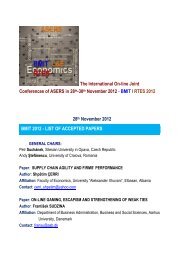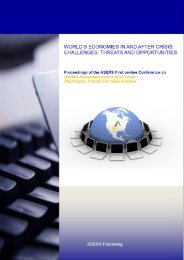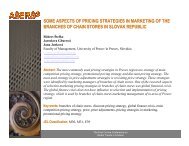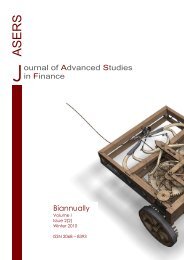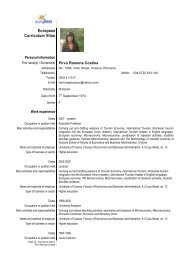Can Shift to a Funded Pension System Affect - ASERS
Can Shift to a Funded Pension System Affect - ASERS
Can Shift to a Funded Pension System Affect - ASERS
You also want an ePaper? Increase the reach of your titles
YUMPU automatically turns print PDFs into web optimized ePapers that Google loves.
Theoretical and Practical Research in Economic Fields<br />
.5<br />
-0.2<br />
.2<br />
.4<br />
-0.4<br />
.1<br />
.3<br />
.2<br />
-0.6<br />
-0.8<br />
.0<br />
.1<br />
-1.0<br />
-.1<br />
.0<br />
1998 2000 2002 2004 2006 2008<br />
-1.2<br />
1998 2000 2002 2004 2006 2008<br />
-.2<br />
1998 2000 2002 2004 2006 2008<br />
<br />
<br />
<br />
Figure 3. Time varying coefficients for Iceland<br />
As for 1, the coefficient 3 (RINS) shows a similar trends for the same periods. It rises sharply reaching<br />
the peak at the beginning of 1999 and it remained stable till the end of 2003. Afterwards, it continues <strong>to</strong> rise till<br />
2006 when it starts <strong>to</strong> decline dramatically inverting the sign in 2009. A possible explanation of this positive trend<br />
(1998-2006) of the value of 3 could be related <strong>to</strong> tax incentive legislation adopted in 1998 as part of the general<br />
social security reform.<br />
Finally the coefficient 2 (RPAYG) shows a quite stable trend from 1998 till 2004 in which it sharply<br />
decline reaching its minimum value of -1.03 and inverting its path soon after.<br />
It is worth noting that 2 path is specular <strong>to</strong> the paths of 1and 3 . This could be due <strong>to</strong> the opposite<br />
impact on national saving of an unfunded and a funded pension benefits as asserted by the economic theory<br />
(Feldstein 1974, 1996, and Samwick 2000).<br />
5. Policy Implications and Conclusion<br />
According <strong>to</strong> Munnell (1982) a perfect world should be characterized by perfect capital and labour<br />
markets, no uncertainty, no taxes and, in this framework, pension saving should be a perfect substitute for other<br />
kinds of savings. Unfortunately we live in a not perfect world in which there are imperfect markets, taxation,<br />
uncertainties and several different opportunities for savings. Because of that, the complete substitution of pension<br />
saving for other forms of savings may not occur. Hence, should be reasonable <strong>to</strong> expect that countries which<br />
have funded occupational pension scheme would have higher national savings rate than countries which do not.<br />
In this work we have tried <strong>to</strong> examine the pension systems of Iceland in a more general perspective with<br />
the purpose <strong>to</strong> analyse how its retirement income provisions have evolved in<strong>to</strong> a multi-pillar arrangement and its<br />
impact on national saving. Moreover, we would like <strong>to</strong> ask – without completely answering the question – if there<br />
are important lessons for others in Iceland‟s pension experience.<br />
Icelandic occupational fully funded pension plans have become just as important as the public pay-as-yougo<br />
system, while the latter is the dominant pillar in many other OECD countries. It is also worth noting the<br />
differences in aging population structure and in social security his<strong>to</strong>ry of this country as describe in section 3.2.<br />
The novelty aspects of our results can be summarized as follow.<br />
Firstly, in this work a combinations of different econometric methodologies have been implemented. The<br />
innovative use of these methodologies allowed us <strong>to</strong> overcome the critics about the ambiguous impact of social<br />
security variables on national saving and <strong>to</strong> get time varying coefficients in order <strong>to</strong> show the reaction of national<br />
saving <strong>to</strong> the implementation of private second pension pillar.<br />
Secondly, we have found substantial evidence that a manda<strong>to</strong>ry pension fund has a positive impact on<br />
national saving in Iceland. Moreover the results showed that unfunded pension pillar had a negative influence on<br />
national saving as predicted by the theory. These findings are consistent with the current empirical literature.<br />
Moreover, using the Kalman filter methodology we were able <strong>to</strong> show that, the pattern of the coefficients of<br />
private pension, pay-as-you-go and life insurance, capture the economic dynamic of the period.<br />
Nevertheless, the following two elements can be considered as the main policy implications for others.<br />
As discussed in section one, the results exhibit that the social security reform that takes the form of threepillar<br />
system is, in particular, beneficial for small open economies. In fact, in small open economy, the effects on<br />
financial market development are much clearer due <strong>to</strong> the contribute of inflow of capital on pension funds. This<br />
effect can be different in magnitude depending on the degree of openness and the financial integration of the<br />
24



